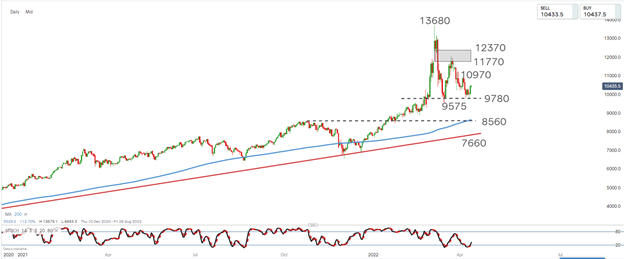Key factors affecting the oil price outlook
In this article we balance some of the key supply and demand issues affecting the oil price and its outlook.
 Source: Bloomberg
Source: Bloomberg
Key factors affecting the oil price right now
The long term trend for oil remains up depsite the recent retrace from highs we have seen. Markets are currently digesting the impacts of a number of supply and demand catalyst which we look to highlight below.
The war continues
In recent news Russian president Vladimir Putin has suggested that the war with Ukraine will continue as talks between the two nations have reached a ‘dead end’, that’s according to reports from Moscow. Russia a major producer of oil (between 8% and 12% of global supply) will in turn continue to see sanctions limiting exports from the region.
OPEC+ marginal uplift in supply
The organisation of Petroleum Exporting Countries (OPEC) and its allies (OPEC+) have suggested that a supply shortage does not exist in the current market environment. In turn May will see only a marginally higher increase in output (+432 barrels per day) from supply increases seen in previous months (+400 000 barrels per day).
US and Allies releasing reserves
Over the next six months, the US will look to help ease supply disruptions by drawing on 1 million barrels per day over the next six months. This aggregates to roughly 180 million barrels per day over the half year period. In addition to this, member countries of the International Energy Agency (IEA) have agreed to release another 120 million barrels of crude oil from reserve stockpiles.
EU could also halt energy imports from Russia
The executive committee of the European Union (EU) is said to be looking at also banning imports of Russian energy such as oil and gas in the near future. Russian crude makes up roughly 25% of oil imports into the region. The decision is not yet finalised as technical details still need to be ironed out.
Some countries within the 27 member EU state (such as Bulgaria and Hungary) are almost fully dependent on oil imports from Russia and are unlikely to be able to support the proposal. Germany, the largest economy within the EU has also not yet lent its full support to the suggested sanctions, although the region does aim to reduce its dependancy on climate inefficient energies.
Chinese oil imports have declined
China reported a dramatic drop in oil imports (nearly 50%) for March, reminding markets of the impact of Covid-19 pandemic can still have on the demand side of the economy. China is the second largest importer of crude (after the US) and has seen its zero-tolerance policy on Covid-19 equate to a hard lockdown in the month, pausing a substaintial amount of economic activity. As the region emerges from lockdown, demand is however expected to increase, although will still be negatively impacted in the second quarter of the year.
Brent Crude – Technical view
 Source: ProRealTime
Source: ProRealTime
The long term trend for brent crude remains up as the price continues to trade well above the 200 day simple moving average (SMA) (blue line). A short term correction of this uptrend has seen prices finding support around the $97.80/barrel mark. A price reversal off this support level suggests renewed gains to follow with $109.70/barrel the initial upside resistance target. A close below $95.75/barrel would suggest the rebound from support to have failed.
In conclusion
Global oil remains in tight supply as minimal output increases from OPEC+ meets sanctions on Russian crude exports. This supply issue could be furthered should the EU move in favour of banning energy imports from the region. The US and ally members of the IEA have moved to try help balance the oil market with plans to release reserve stockpiles of the commodity over coming months. The demand side for oil has temporary waned with the pandemics disruption to economic activity in China.
On balance it appears that risks to oil prices remain to the upside. OPEC+ have given little indication that output will be substantially increased over the near future. While relief measures from the US and IEA have supported a correction oil prices, they are at this stage only temporary.
The war is ongoing without an end in sight, so supply from Russia appears very unlikely to return to market anytime soon. Demand from major importers such as China is expected to gradually improve as pandemic disruptions abate. The long term trend for oil is up and charts suggest that the in the short term they may even be oversold and setting up to renew gains.







0 Comments
Recommended Comments
There are no comments to display.
Create an account or sign in to comment
You need to be a member in order to leave a comment
Create an account
Sign up for a new account in our community. It's easy!
Register a new accountSign in
Already have an account? Sign in here.
Sign In Now